
Nudibranchs are a group of soft-bodied marine gastropod molluscs that shed their shells after their larval stage. They are noted for their often extraordinary colours and striking forms, and they have been given colourful nicknames to match, such as "clown", "marigold", "splendid", "dancer", "dragon", and "sea rabbit". Currently, about 3,000 valid species of nudibranchs are known.

Sea slug is a common name for some marine invertebrates with varying levels of resemblance to terrestrial slugs. Most creatures known as sea slugs are gastropods, i.e. they are sea snails that over evolutionary time have either completely lost their shells, or have seemingly lost their shells due to having a greatly reduced or internal shell. The name "sea slug" is most often applied to nudibranchs, as well as to a paraphyletic set of other marine gastropods without obvious shells.

The Spanish dancer, scientific name Hexabranchus sanguineus, is a dorid nudibranch, a very large and colorful sea slug, a marine gastropod mollusk in the family Hexabranchidae.The taxonomy of the genus Hexabranchus has been controversial but a thorough molecular and morphological study published in 2023 showed that the name H. sanguineus was being used for at least 5 distinct species.
External fertilization is a mode of reproduction in which a male organism's sperm fertilizes a female organism's egg outside of the female's body. It is contrasted with internal fertilization, in which sperm are introduced via insemination and then combine with an egg inside the body of a female organism. External fertilization typically occurs in water or a moist area to facilitate the movement of sperm to the egg. The release of eggs and sperm into the water is known as spawning. In motile species, spawning females often travel to a suitable location to release their eggs.

Glaucus atlanticus is a species of small, blue sea slug, a pelagic (open-ocean) aeolid nudibranch, a shell-less gastropod mollusk in the family Glaucidae.

Penis fencing is a mating behavior engaged in by many species of flatworm, such as Pseudobiceros hancockanus. Species which engage in the practice are hermaphroditic; each individual has both egg-producing ovaries and sperm-producing testes.
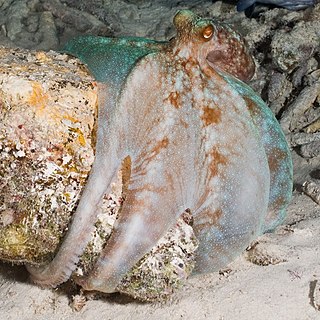
The Caribbean reef octopus is a coral reef marine animal. It has eight long arms that vary in length and diameter. The mantle is large and chunky in comparison. This species is difficult to describe because it changes color and texture to blend into its surroundings, using specialised skin cells known as chromatophores. Its color range is very large; it can change from crimson to green, and bumpy to smooth. It weighs around 3.3 lb or 1.5 kg.

Aplysia vaccaria, also known as the black sea hare and California black sea hare, is a species of extremely large sea slug, a marine, opisthobranch, gastropod mollusk in the family Aplysiidae. It is the largest sea slug species.
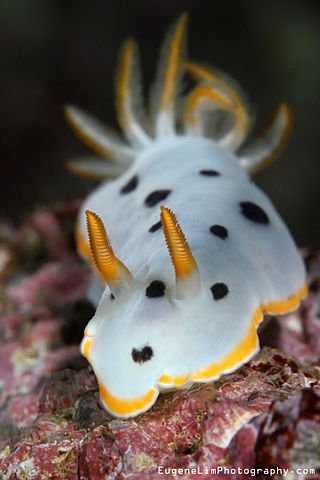
Chromodoris orientalis is a species of colourful sea slug, a dorid nudibranch, a marine gastropod mollusc in the family Chromodorididae. Sea slugs are generally very beautifully colored organisms with intense patterns and ranging in sizes. The Chromodoris orientalis specifically is a white sea slug with black spots in no particular pattern with a yellow, orange, or brown in color ring around its whole body and on its gills. There is much discussion on where it is found, what it eats, how it defends itself without a shell, and its reproduction methods. This is all sought after information because there is not much known about these animals.

Tritonicula hamnerorum is a species of dendronotid nudibranch. It is a marine gastropod mollusc in the family Tritoniidae. A number of Caribbean species of Tritonia were moved to a new genus Tritonicula in 2020 as a result of an integrative taxonomic study of the family Tritoniidae.

Drupella cornus, common name : the horn drupe, is a species of sea snail, a marine gastropod mollusk in the family Muricidae, the murex snails or rock snails.
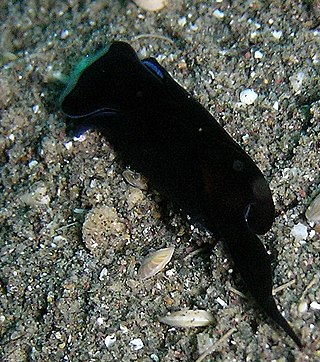
Chelidonura sandrana is a species of sea slug, or "headshield slug", a marine opisthobranch gastropod mollusk in the family Aglajidae.

A corallivore is an animal that feeds on coral. Corallivores are an important group of reef organism because they can influence coral abundance, distribution, and community structure. Corallivores feed on coral using a variety of unique adaptations and strategies. Animals known to be corallivores include certain mollusks, annelids, fish, crustaceans, flatworms and echinoderms. The first recorded evidence of corallivory was presented by Charles Darwin in 1842 during his voyage on HMS Beagle in which he found coral in the stomach of two Scarus parrotfish.

Phestilla lugubris is a species of sea slug, an aeolid nudibranch, a marine gastropod mollusk in the family Trinchesiidae.
Phestilla sibogae is a species of sea slug, an aeolid nudibranch, a marine gastropod mollusk in the family Trinchesiidae. The species feeds on the hard coral genus Porites.
Phestilla panamica is a species of sea slug, an aeolid nudibranch, a marine gastropod mollusk in the family Trinchesiidae. The species feeds on the hard coral genus Porites.
Phestilla poritophages is a species of sea slug, an aeolid nudibranch, a marine gastropod mollusk in the family Trinchesiidae. The species was named after its prey genus, the hard coral Porites.
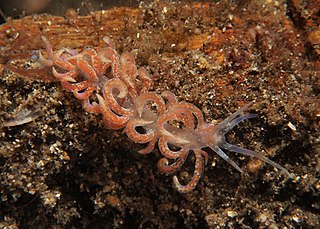
Phyllodesmium poindimiei is an Alcyonacea feeding, aeolid nudibranch Gastropod belonging to the family Facelinidae. Cerata are important in this clade in terms of their physical defense and efficient metabolic processes. This species is spread sporadically along tropical coastal regions such as Australia, Hawaii, and the Indo-Pacific living in diverse marine habitats such as coral reefs. Unlike other species in the Opisthobranch Mollusca clade, P. poindimiei’s lush pink cerata are used for defensive purposes other than Nematocyst (dinoflagellate) capture and toxin release. Organismal ties within these thriving, tropical ecosystems can be determinants of environment change, which affects massive coral ecosystems. Continuously changing marine ecosystems, such as coral reefs, are directly linked to the evolution of organisms that live and thrive in the tropics such as the soft nudibrach P. poindimiei.

Berthellina citrina, the orange gumdrop, is a species of sea slug in the family Pleurobranchidae. It is found in rock pools in the intertidal zone and in shallow water in the tropical and subtropical Indo-Pacific region.
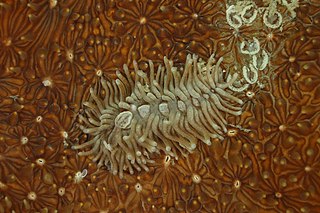
Phestilla viei is a species of coral-feeding sea slug, an aeolid nudibranch, from the family Trinchesiidae, described in 2020. It has been identified as a sister species of Phestilla fuscostriata based on DNA barcoding using the COI gene. The genus Phestilla currently includes nine recognized species, eight of which are obligate corallivores, with each particular species predating on only one species or genus of coral. Its distribution is restricted to the Indo-Pacific Ocean.
















